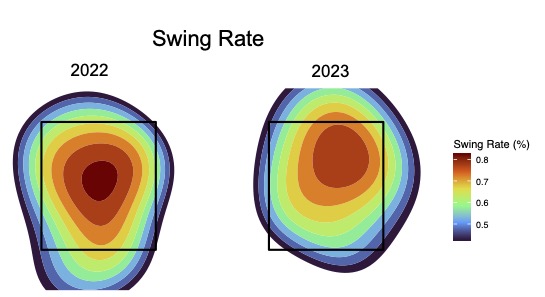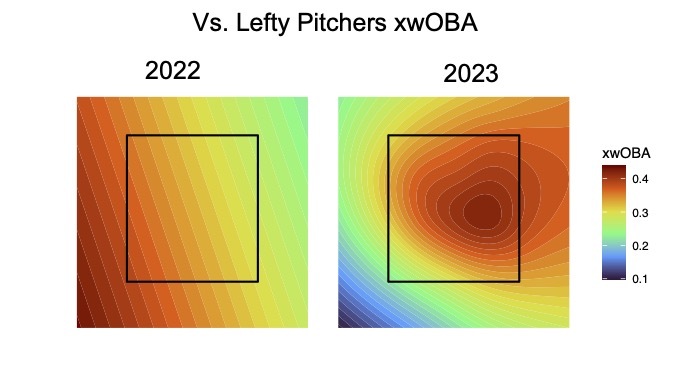© 2024 ALLCITY Network Inc.
All rights reserved.

There’s no question that, when the calendar flipped to August, Cody Bellinger was as deserving as anyone else to be named the National League Player of the Month for July.
Sure, other players had good arguments. But Bellinger was among the league’s top hitters throughout the month, as his 1.8 fWAR (tied for first in the NL in July), .400 batting average (first), 1.122 OPS (second) and 198 wRC+ (third) help exemplify. But even beyond that, Bellinger led the way as the Cubs racked up 15 wins in July, tied for the most in the NL over the month.
Obviously, it’s extremely difficult for one player to change a group’s fortunes over an extended period of time. But the Cubs surely feel like there was some correlation between Bellinger’s offensive outburst and their stretch of play that convinced the front office to buy at the trade deadline last week.
“There’s moments in the season where you feel like a guy carries you as a player, carries the team, puts them on his back,” Cubs manager David Ross said. “I thought he did that for us in a moment where, especially early on, we weren’t swinging the bats really well, and he was the one putting up the homers to give us a little bit of lead, give us some cushion, be aggressive in the zone with our pitching staff.
“That’s the stuff when you talk about MVP-type-player-caliber months that he had [and] is having. I think those little things make such a big difference when you’re putting up those kinds of at-bats and those numbers, offensively. It just makes the whole team that much better.”

Overall this season head into Tuesday, following a 3-for-3 night during the Cubs’ 11-2 loss to the Mets on Monday, Bellinger is slashing .332/.383/.552, has a career-low 15 percent strikeout rate and owns a 149 wRC+. If it isn’t clear, Bellinger is having a tremendous season at this plate for the North Siders.
Whenever he’s asked to describe how he’s feeling offensively, feeling healthier than he has in the past few seasons is a factor, but he generally keeps the explanation pretty simple.
“I feel really good, man,” Bellinger said in a recent media scrum. “Just the understanding of my body and strength and what I need to do every day. Honestly, like I keep saying, I just show up to help the team win. I really do. Go out and play baseball.”
There, of course, is more to it than that. Taking a deeper look at his numbers provides some clues as to what has him hitting more like the 2019 NL MVP version of himself.
Bellinger is something of a unicorn hitter. Rarely do you see sluggers hit for eye-popping power without much swing and miss. When Bellinger won his lone MVP four years ago, he barreled 47 homers with an astonishing 78 percent contact rate. In comparison, batters who typically hit for 30-plus homers tend to have contact rates around 70 percent.
However, his contact-power combination regressed the last two seasons. After suffering a shoulder injury in the 2020 postseason, he reverted to a hitter with moderate power and below average contact (2021: 72 percent; 2022: 75 percent).
Now, as a Cub, he’s making more contact than ever (82 percent percent) and on pace for a 30 home run/600 plate appearance season. It’s easy to point to Bellinger’s health as a driving force behind his re-emergence, but that’s only part of the equation, according to Cubs hitting coach Dustin Kelly.
“Going into spring training, he’s 100 percent healthy, right?” Kelly said in a conversation with CHGO. “Then he started to get all the strength back. So, adding those two things onto just the pure athletic ability put him in a really confident space. And then he started to work through some of the timing things that you go through in spring training, it just became, like, we started to see the bat speed and the whip and him just getting into a lot of those same positions that he was in in ’19.
“His bat plane has been really good. He’s been able to stay on balls, be pretty short and direct, and he’s not losing the barrel underneath like he had been in the past.”
There’s also been some evolution in the way teams attack Bellinger. At one point, said Kelly, teams challenged Bellinger with elevated pitches.
Interestingly, it seems as if those are the ones he’s has liked the most as compared to last season. Bellinger is swinging at more pitches towards the top-third of the strike zone and fewer pitches in the bottom-third. And whereas he swung at 60-70 percent of pitches at the knees last year, he’s only swinging at 40-50 percent of similarly low pitches (as shown in the below graph).

And Bellinger is doing severe damage against these top-zone pitches. With the Cubs this year, he has a .350-plus wOBA against top-zone pitches, compared to below .300 last year his last season with the Dodgers.

The plan of attack has changed as Bellinger has continued to succeed against whatever opposing pitchers throw at him. Kelly said other teams seemed to change to trying to dump curveballs in early to try to steal a strike. But especially since his return from his left knee injury in mid-June, said Kelly, Bellinger has “proven over the past couple months that he handles all of that.”
And then, what would seemingly be the easiest way to attack Bellinger gets neutralized.
Lefty-on-lefty matchups generally aren’t great for hitters. This season in Major League Baseball, left-handed hitters are hitting just .240 with a .690 OPS and a .305 wOBA versus left-handed pitchers. There’s a reason many managers load up their lineups with righties when an opposing southpaw is on the mound.
Indeed, Bellinger’s numbers against lefties are absurd this season. When southpaws attempt to throw inside to him, he has put up over a .350 xwOBA. The book has changed. No longer can you beat Bellinger with elevated pitches and inside. Lefties can’t even do it.

Bellinger is one of the best major league hitters in lefty-on-lefty matchups. His .358 average, 1.052 OPS, .443 wOBA and 183 wRC+ in those situations all rank second in MLB (among left-handed batters with at least 100 plate appearances versus left-handed pitchers). It’s just another reason why opponents struggle to get him out — and why he remains in the heart of the Cubs’ order, regardless of who’s on the mound.
“The way that he’s crushing lefties right now, it adds another layer into it that they can’t even bring in a lefty to try and match up against him, because he’s hitting equally as good against lefties and righties,” Kelly said. “That just goes back to how well he prepares and how well he just stays in on lefties. He doesn’t bail out. His line stays exactly the same. He’s a tough matchup for any manager over there.”
That’s not to mention his situation hitting. In all two-strike counts combined, Bellinger has been the Cubs’ most reliable hitter, posting a .302 average, a .767 OPS and a .332 wOBA. His slugging comes down in those situations (.426 versus .552 overall) — and overall, his hard-hit rate and average exit velocity aren’t anywhere close to the top of the league — but there’s a simple, professional-hitter type of explanation.
“I talk about it all the time: Guys have different clubs in their bags, and the best hitters have multiple clubs,” Kelly said. “He has the driver, which we’ve seen hitting balls off the scoreboard, but then he also has that seven or eight-iron where he can shoot a ball to left-center and get it over the shortstop’s head and in front of the left fielder. He can scoot a ball through the six-hole, he can beat out a ball up the middle. He just has a lot of clubs in his bag, and it’s hard to get out.
“That’s him being perfectly OK toning down his swing, knowing that he has the ability to get on base and he can steal second because the speed is back. So, he has all of that stuff in his repertoire, and he’s using all of it right now.”
There’s a reason why Bellinger was the best hitter on the market when the Cubs seemed to be in position to sell. He just seems to come through in every situation the team needs him to.
Losing Bellinger at the trade deadline would’ve taken all of this away from the Cubs’ lineup for the last stretch run of the season. So, while some may have been disappointed the front office didn’t make more additions last week, the biggest move the Cubs could’ve made was holding onto Bellinger the rest of the year.
“I could say he’s been everything we expected, but he’s been even better than we expected,” Cubs president of baseball operations Jed Hoyer said. “He’s played like he did in ’18, ’19 and ’20 for the Dodgers. He’s been fantastic. You’ve seen how he interacts with our players, how he is in the clubhouse, how he is on the team. He’s a huge part of why we have so much confidence in this team.”
Get Our Best Cubs Content In Your Inbox!Become a smarter Chicago Cubs fan with Ryan Herrera's Cubs Newsletter!
Just drop your email below!
Comments
Share your thoughts
Join the conversation


